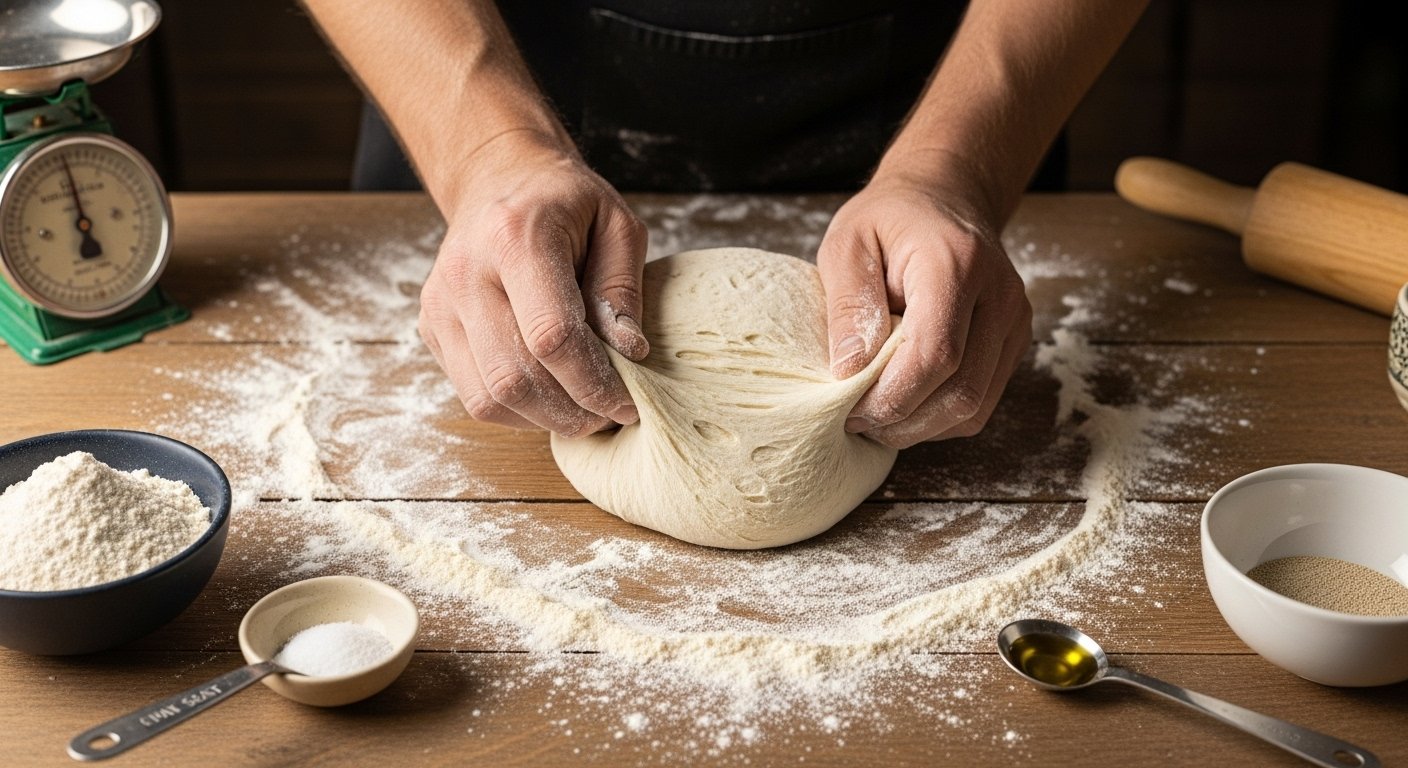Are you ready to transform your home kitchen into a traditional Neapolitan pizzeria? Crafting authentic Neapolitan pizza dough at home is a rewarding culinary journey that promises a truly unforgettable pizza experience. Mastering key techniques, including cold fermentation, creates the delicate, airy crust for authentic Neapolitan pizza. Many Americans want to master this skill; 27% prefer making pizza at home. This guide helps you make Neapolitan pizza crust that rivals Naples’ best.
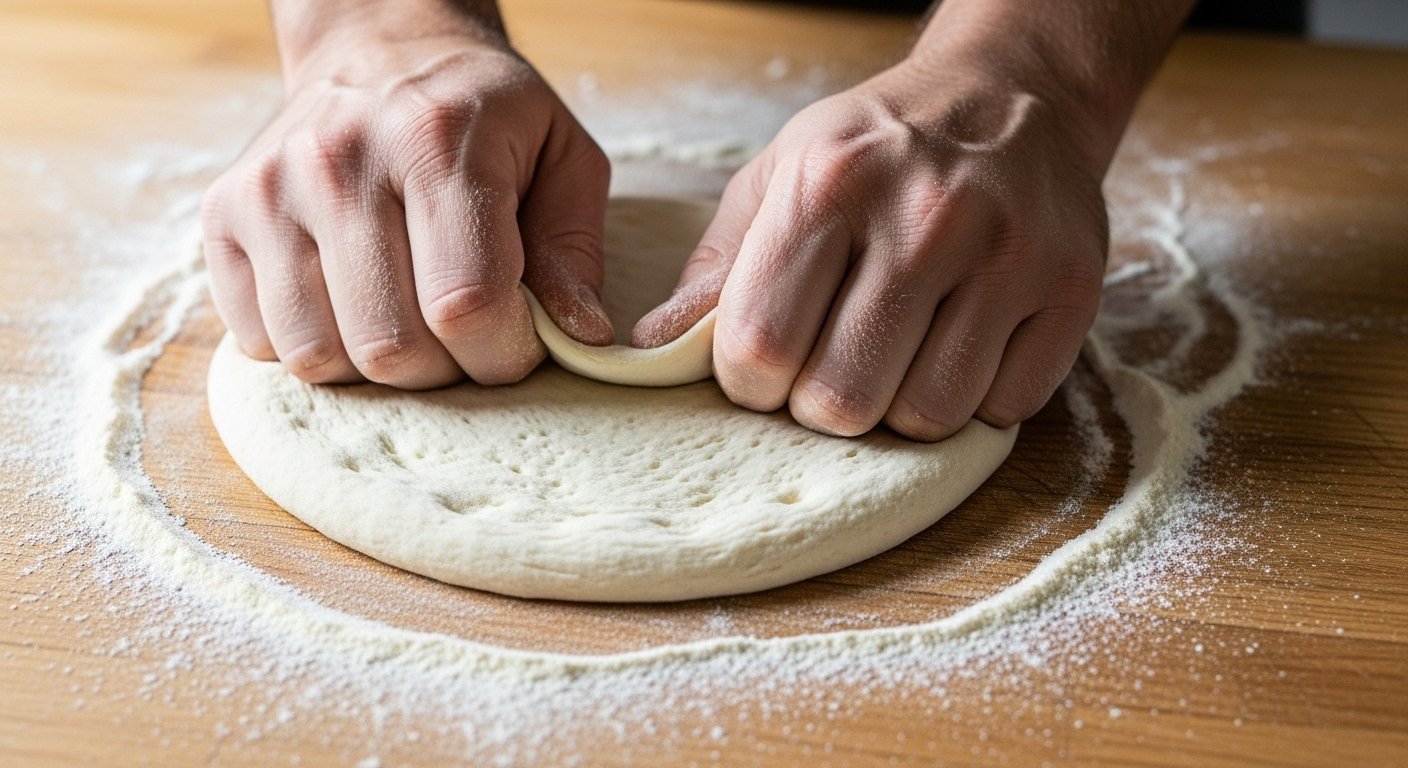
What Makes Neapolitan Pizza Dough Authentic?
Neapolitan Pizza Dough is a strict tradition, not just a recipe. Rigid standards preserve its integrity. The AVPN is the global authority, setting guidelines for authentic Neapolitan pizza. This ensures traditional methods are followed. Specific Neapolitan ingredients and techniques create the dough’s soft, elastic, foldable crust and blistered cornicione. [16] It’s this delicate balance of 00 flour, water, salt, yeast, long fermentation, and high-temperature baking that defines its characteristic texture and flavor. The goal is a pizza crust texture that is crisp on the outside and wonderfully soft and airy on the inside. [13]
Essential Ingredients for Authentic Neapolitan Pizza Dough
To make real Neapolitan pizza dough, the quality and type of your ingredients are paramount. The AVPN specifies only four core components: 00 flour, water, salt, and yeast. These four ingredients, combined with proper technique, are all you need to begin your Neapolitan pizza journey.
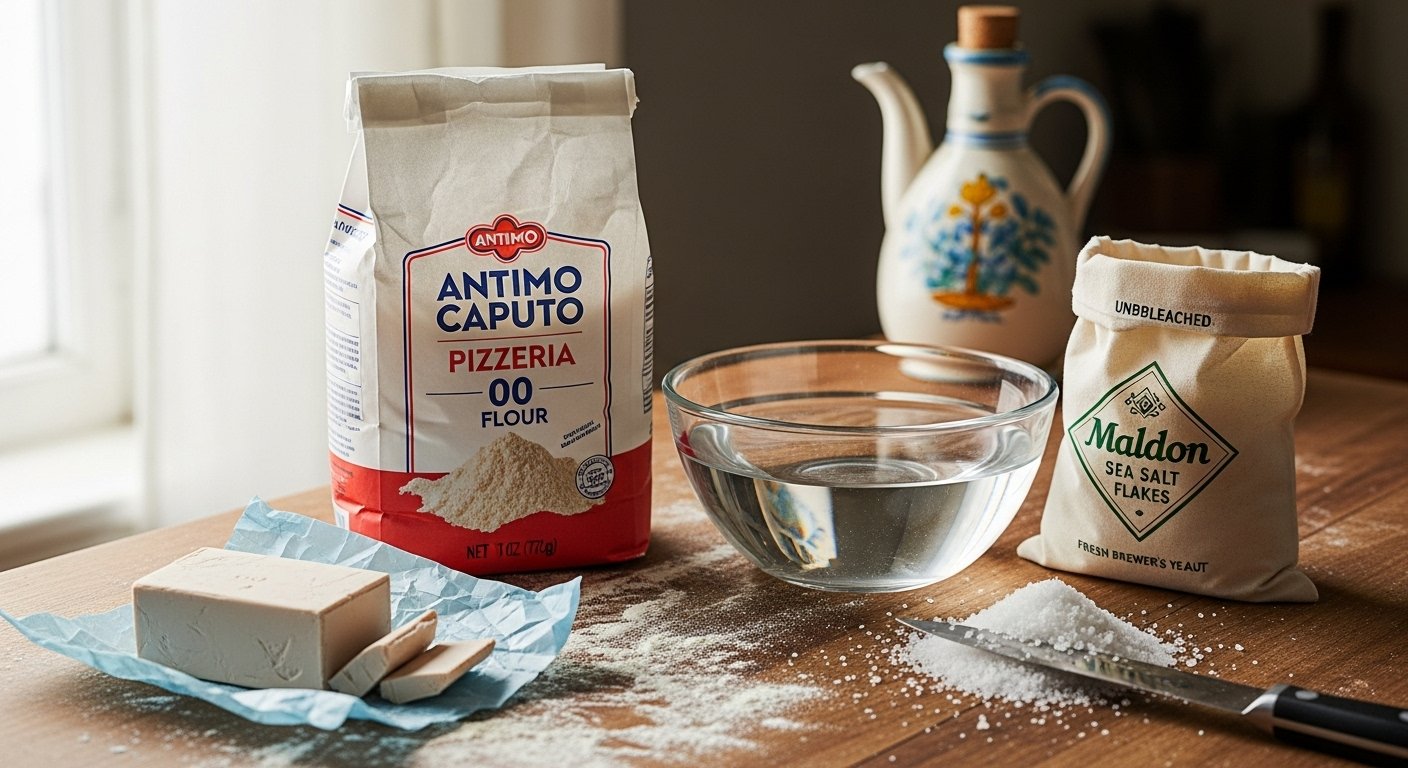
What Type of Flour is Best for Neapolitan Pizza Dough?
For authentic Neapolitan pizza, ’00’ flour is the undisputed champion. This finely milled Italian flour, specifically designed for high-temperature baking, creates a soft, airy crust. Its unique soft wheat composition develops a delicate gluten structure, making the dough easy to handle and stretch thin without tearing. This allows the pizza to cook quickly, developing the signature leopard-spotted crust and characteristic chewiness while staying light. While strong bread flour can be an alternative, ’00’ flour is essential for genuine Neapolitan results.
Water
Clean, cool water is crucial. The precise Neapolitan pizza dough hydration percentage typically falls between 55% to 65% of the flour’s weight. Using a high hydration pizza dough Neapolitan recipe results in a more pliable and airy crust. The exact percentage can vary slightly depending on the specific 00 flour brand and ambient humidity, but aiming for a dough that feels slightly sticky but manageable is ideal. This high hydration contributes to the delicate crumb and open structure of the finished pizza.
Salt
Fine sea salt is traditionally used. It not only adds flavor but also helps to strengthen the gluten structure and regulate fermentation. Use non-iodized salt, as iodine can sometimes interfere with yeast activity.
What Yeast for Neapolitan Pizza Dough?
Fresh brewer’s yeast (also known as fresh cake yeast) is the traditional choice, used in very small quantities. If fresh yeast is unavailable, instant dry yeast can be substituted at a ratio of 1:3 (e.g., if a recipe calls for 1 gram of fresh yeast, use 0.33 grams of instant dry yeast). The key is to use minimal yeast and allow a long fermentation period, which develops superior flavor and texture.
Step-by-Step: How to Make Authentic Neapolitan Pizza Dough
Making real Neapolitan pizza dough at home involves patience and adherence to a few key techniques. This easy Neapolitan pizza dough recipe will guide you through the process, leading to a perfect homemade Neapolitan pizza crust.
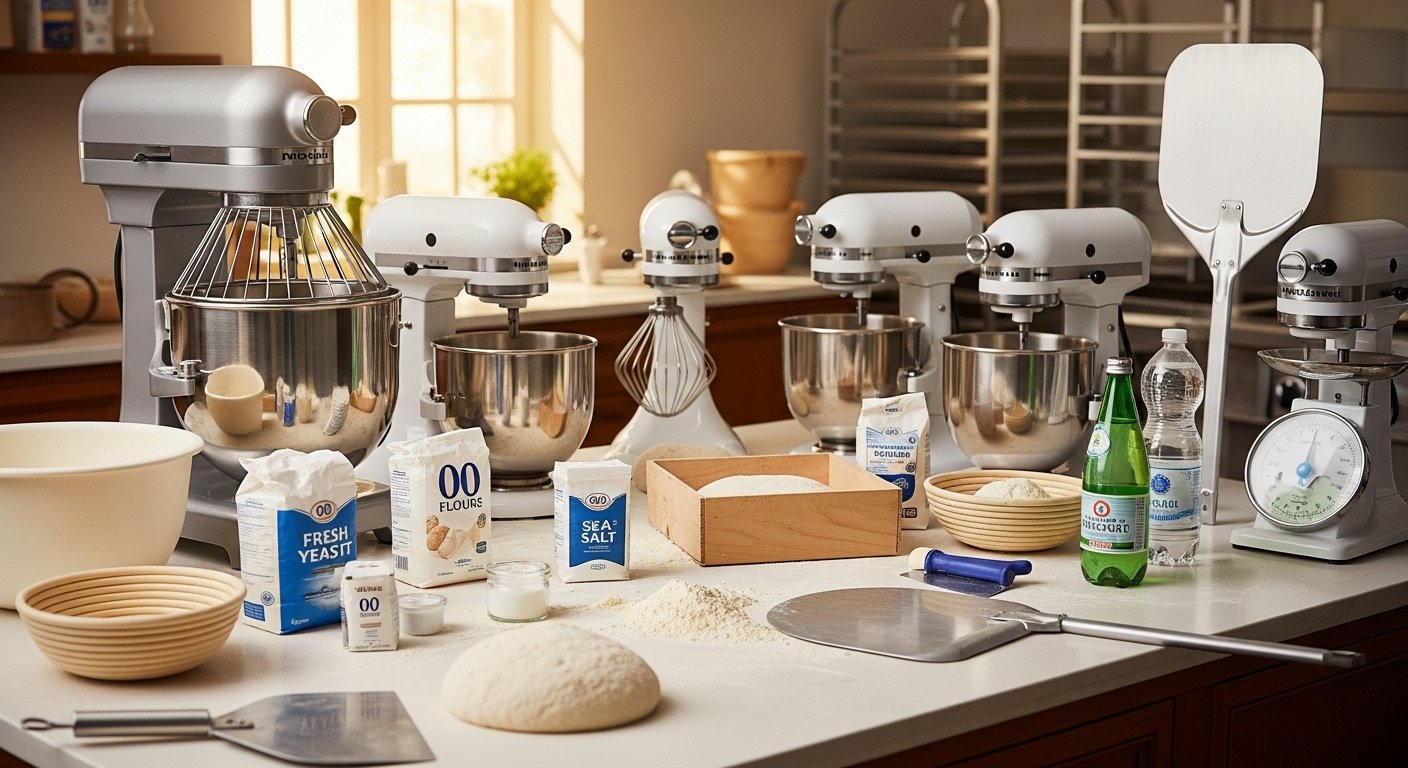
Equipment You’ll Need
- Large mixing bowl or a stand mixer with a dough hook. For recommendations on mixers, check out our guide on stand mixers.
- Kitchen scale (essential for accurate ingredient measurements).
- Large, airtight containers or proofing boxes.
- An essential tool: a dough scraper.
- Pizza peel (if using a pizza oven).
- Pizza oven (wood-fired oven for true authenticity, but a very hot home oven or pizza steel/stone can work).
Ingredients (for 4-6 pizzas)
- 1000g (about 8 cups) 00 flour (e.g., Caputo Pizzeria or Classica)
- 600-650ml (about 2.5-2.75 cups) cool water (55-65% hydration)
- 25-30g (about 1.5-2 tablespoons) fine sea salt
- 0.5 – 1g (1/8 – 1/4 teaspoon) fresh brewer’s yeast OR 0.2 – 0.3g instant dry yeast
Initial Dough Preparation
Mixing the Dough (Neapolitan Pizza Dough Kneading Technique)
1. Activate Yeast (Optional for fresh yeast): If using instant dry yeast, you can mix it directly with the flour. If using fresh yeast, dissolve it in a small portion (about 50ml) of the measured cool water. Let it sit for 5-10 minutes until foamy, indicating it’s active.
2. Combine Water and Salt: In a large mixing bowl, combine the remaining cool water and the salt. Stir until the salt is fully dissolved.
3. **Add Flour G…### Bulk Fermentation (First Rise): How Long to Ferment Neapolitan Pizza Dough?
This is where long fermentation truly shines. After kneading, form the dough into a smooth ball. Place it in a lightly oiled, large airtight container or bowl. Cover tightly. This is the stage for cold fermentation pizza dough Neapolitan style.
- Room Temperature Initial Rise (Optional but Recommended): Some prefer an initial 1-2 hours at room temperature (around 68-75°F / 20-24°C) to kickstart yeast activity before moving to the cold fermentation.
- Cold Fermentation: Transfer the covered dough to the refrigerator for a slow, cold fermentation. How long should Neapolitan pizza dough ferment? This typically ranges from 24 to 72 hours, though some go up to 96 hours. [10] The longer the cold fermentation pizza dough Neapolitan, the more complex the flavors will become, and the dough will be easier to digest and handle due to the enzymes breaking down starches and proteins. [3, 13, 14] This process helps develop amino acids that contribute to browning and flavor during baking. [3] This extended period is vital for the Vera Pizza Napoletana dough recipe.
Dividing and Shaping Dough Balls
After cold fermentation, remove the dough from the refrigerator. Let it come to room temperature for 1-2 hours. Gently turn the dough out onto a lightly floured surface. Using a dough scraper, divide the dough into individual balls, each weighing between 200-250 grams (for a standard 10-12 inch pizza). To form the balls, gently cup a piece of dough with your hand and roll it against the counter, creating surface tension. You can also fold the edges of the dough underneath itself to create a tight ball.
Second Proofing (Dough Proofing Tips)
Place the dough balls in individual proofing containers or a proofing box, ensuring they have enough space to expand without touching. Lightly dust with flour to prevent sticking. Cover them and let them proof at room temperature (68-75°F / 20-24°C) for another 4-8 hours. The dough balls should nearly double in size and feel very soft and airy. This final proofing stage is crucial for achieving the desired pizza crust texture and helps in how to stretch Neapolitan pizza dough without tearing.
Stretching Your Neapolitan Pizza Dough
This is a delicate art. The goal is to stretch the dough by hand, preserving the air bubbles developed during fermentation. Avoid using a rolling pin, which will flatten the precious air in the crust. Gently lift a dough ball and, using your fingertips, press from the center outwards, leaving a small raised rim (the cornicione). Then, carefully stretch the dough by draping it over your knuckles or by rotating it on your hands, allowing gravity to gently pull it into a round shape. Your homemade Neapolitan pizza crust depends on this gentle handling.
Baking for Perfection
Authentic Neapolitan pizza is baked rapidly (60-90 seconds) at extremely high temperatures (800-950°F / 425-510°C) in a wood-fired oven. While a true wood-fired oven might be a dream for many, the global home pizza oven market was valued at approximately USD 2.8 billion in 2024 and is anticipated to reach USD 4.7 billion by 2033, indicating a rising consumer preference for authentic experiences at home. For home bakers, a pizza steel or stone preheated in the hottest oven setting (usually 500-550°F / 260-290°C) for at least an hour can mimic some of the effects. Place your stretched dough onto a lightly floured or semolina-dusted pizza peel, top quickly, and slide it onto the hot stone/steel. The intense heat will create the characteristic puffy, leopard-spotted cornicione and cook the pizza quickly.
Understanding Neapolitan Pizza Dough Hydration
The Neapolitan pizza dough hydration percentage, typically between 55% and 65%, is a defining characteristic of this style. High hydration dough Neapolitan results in a more extensible and tender dough. While it might be a bit stickier to handle initially, the extra water evaporates during the high-temperature bake, contributing to a light, open crumb structure and a delicate chew. This higher water content also aids in the long fermentation process, allowing the dough to develop complex flavors without drying out. Mastering the hydration level is key to achieving that signature, cloud-like Neapolitan pizza crust texture.
Troubleshooting Common Neapolitan Pizza Dough Issues
Even experienced bakers encounter challenges. Here are a few common issues and how to address them:
- Sticky Dough? High hydration is normal. If excessively sticky, you might have too much water or underdeveloped gluten. Knead more; dust lightly with flour. Stiff dough means under-hydrated. * No Rise? Check yeast freshness, water temperature (lukewarm), and a warm fermentation environment. Cold slows yeast. * Tearing Dough? This indicates underdeveloped gluten or insufficient proofing. Knead adequately to build gluten. Allow more proofing time for a relaxed dough.
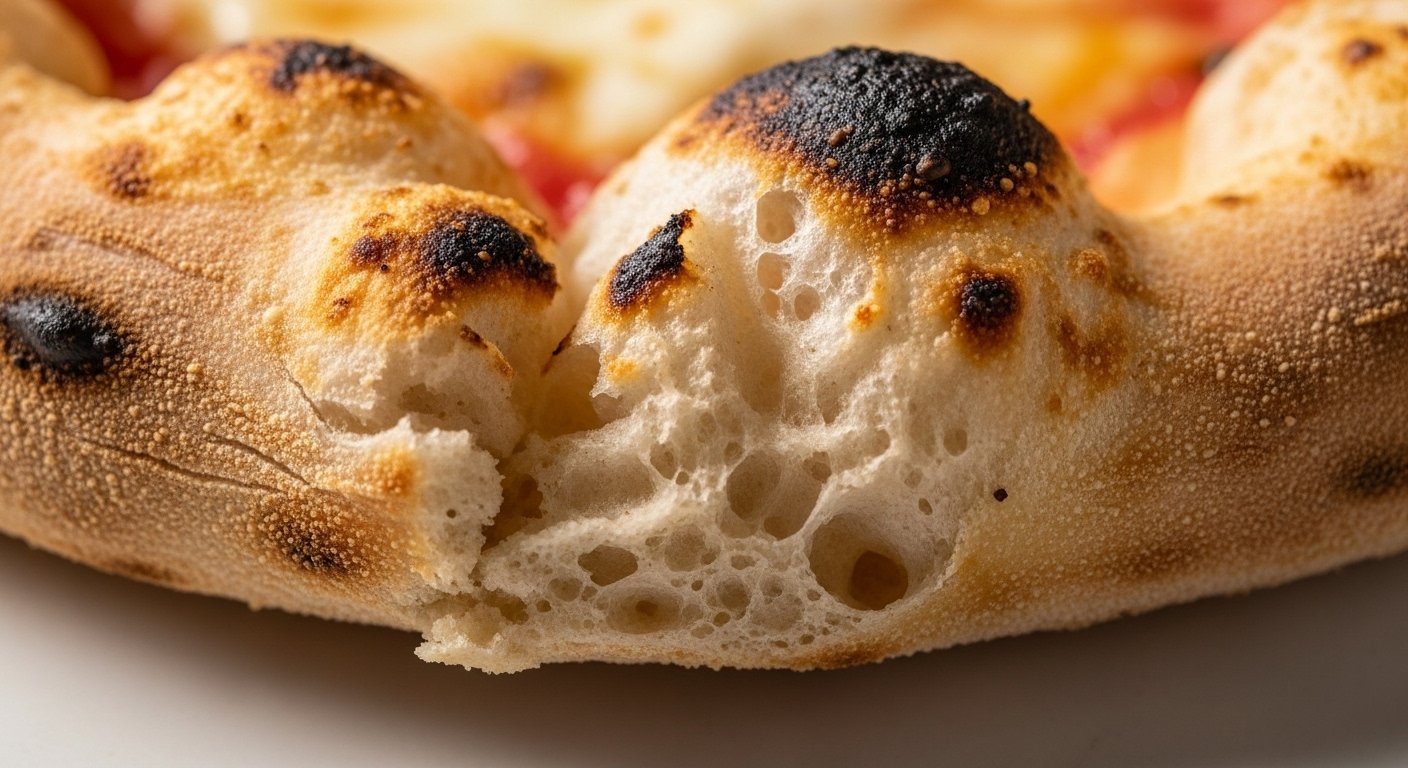
The Science of Fermentation in Pizza Dough
Fermentation is the magical process that transforms simple ingredients into complex flavors and textures. Yeast, in the presence of sugar from the flour, produces carbon dioxide and ethanol. [3, 8] The carbon dioxide gas becomes trapped within the elastic gluten network, causing the dough to rise and creating the airy pockets characteristic of great pizza crust. [10] Simultaneously, enzymes naturally present in the flour break down complex carbohydrates into simple sugars, which the yeast consumes, and also break down proteins (gluten) into amino acids. [3] This proteolysis softens the dough, making it more extensible and easier to work with, while also producing amino acids and peptides that significantly enhance the dough’s flavor and contribute to the browning (Maillard reaction) during baking. [3, 10] A long, slow, cold fermentation allows for these complex flavor compounds to develop, resulting in a more digestible and flavorful homemade Neapolitan pizza crust. [13, 14]
Conclusion: Your Authentic Neapolitan Pizza Dough Journey
Embarking on the journey to make authentic Neapolitan pizza dough at home is a culinary adventure that rewards patience and precision. By understanding the critical role of 00 flour, the nuances of high hydration, the art of Neapolitan pizza dough kneading technique, and the science of cold fermentation, you’re well on your way to mastering the foundation of a truly exceptional pizza. Remember, practice makes perfect, and each batch brings you closer to that ideal, airy, and flavorful homemade Neapolitan pizza crust. With dedication, you can bring the taste of Naples directly to your dining table. The rising interest in home baking, with 31% of consumers baking at home frequently and an additional 24% baking often, suggests that more and more people are discovering the joy and satisfaction of creating artisanal dishes like this at home.
Frequently Asked Questions
What are the 4 ingredients for Neapolitan pizza dough?
The four essential ingredients for authentic Neapolitan pizza dough are 00 flour, water, salt, and fresh brewer’s yeast (or a minimal amount of instant dry yeast). No other ingredients like oil or sugar are traditionally used in the dough itself.
Can I use regular all-purpose flour instead of 00 flour?
While you can technically make pizza dough with all-purpose flour, it will not yield an authentic Neapolitan pizza crust. 00 flour has a specific protein content and very fine grind that creates a delicate, airy, and extensible dough ideal for the high-temperature, short bake of Neapolitan pizza. All-purpose flour typically results in a chewier, denser crust and may not brown correctly in a home oven at lower temperatures compared to a wood-fired oven. [6]
How long does Neapolitan pizza dough need to ferment?
Authentic Neapolitan pizza dough typically undergoes a long fermentation process, usually between 24 to 72 hours, often including a cold fermentation period in the refrigerator. This extended time allows for complex flavors to develop and the dough to become more digestible and pliable. Some recipes may even call for up to 96 hours of fermentation. [10]
Can you make Neapolitan pizza dough without a wood-fired oven?
Yes, you can make Neapolitan-style pizza dough without a traditional wood-fired oven. While a wood-fired oven provides the ideal extreme heat (800-950°F / 425-510°C), you can achieve excellent results in a very hot home oven (preheated to its maximum temperature, usually 500-550°F / 260-290°C) with a preheated pizza stone or steel. The key is to achieve as much heat as possible to mimic the rapid cooking of an authentic Neapolitan pizza.
Why is long fermentation crucial for Neapolitan pizza dough?
Long fermentation is crucial because it allows yeast and natural enzymes to slowly break down starches and proteins in the flour. This process develops complex flavors, makes the dough more extensible and easier to stretch, and improves digestibility. It also contributes to the characteristic light, airy texture and open crumb of the authentic Neapolitan pizza crust. [3, 13]
